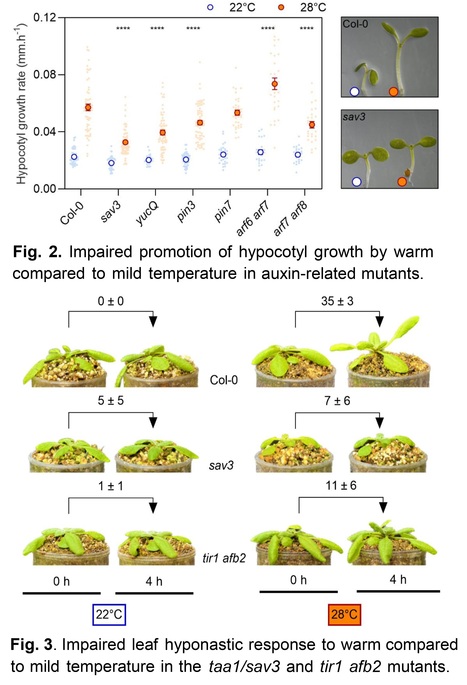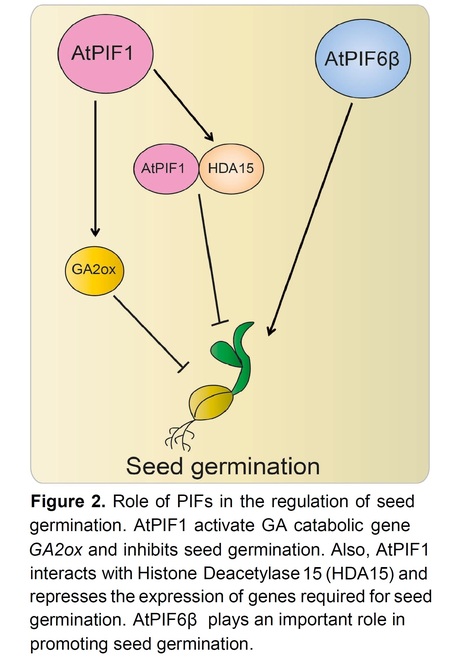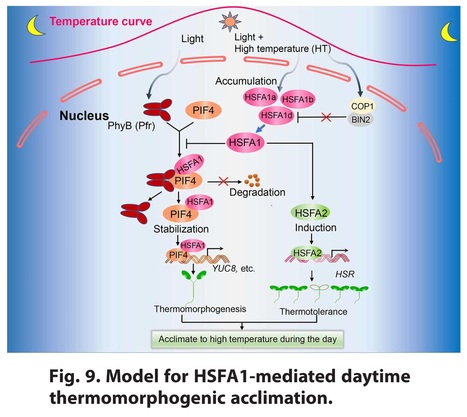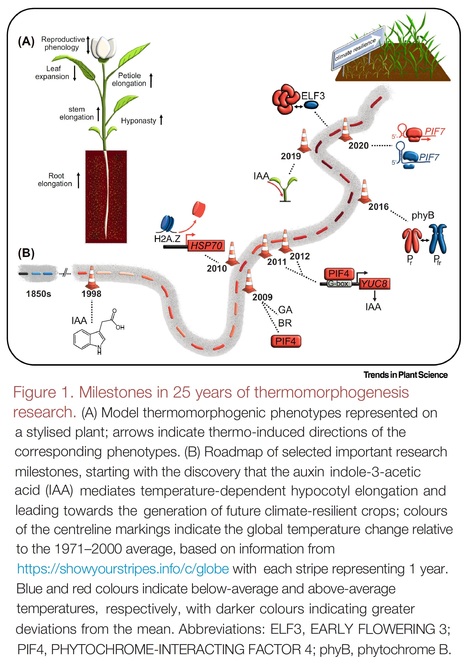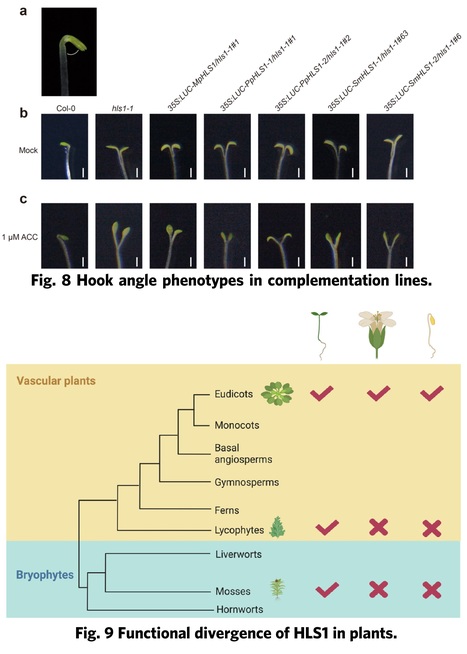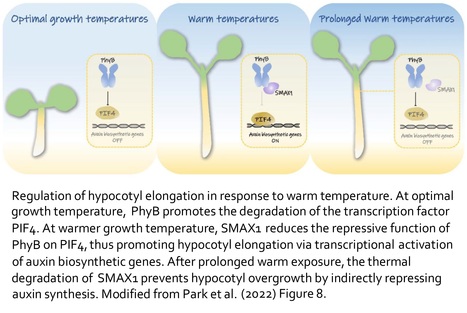 Your new post is loading...
 Your new post is loading...
Authors: Wei Liu, Yuyan Cheng and Ziqiang Zhu (2024)
Journal of Plant Growth Regulation (2024)
Abstract: "The role of auxin in plant root thermomorphogenesis is still under debate. Here, we showed that auxin is necessary for root elongation in either seedling roots or detached roots. Our study clarified the uncertainty in the field and shed new light on future research in plant response to high ambient temperature."
Authors: Young-Joon Park, Bo Eun Nam and Chung-Mo Park.
Journal of Integrative Plant Biology (2024)
Abstract: "Coordinated morphogenic adaptation of growing plants is critical for their survival and propagation under fluctuating environments. Plant morphogenic responses to light and warm temperatures, termed photomorphogenesis and thermomorphogenesis, respectively, have been extensively studied in recent decades. During photomorphogenesis, plants actively reshape their growth and developmental patterns to cope with changes in light regimes. Accordingly, photomorphogenesis is closely associated with diverse growth hormonal cues. Notably, accumulating evidence indicate that the light-directed morphogenesis is profoundly affected by two recently identified phytochemicals, karrikins (KARs) and strigolactones (SLs). KARs and SLs are structurally related butenolides acting as signaling molecules during a variety of developmental steps, including seed germination. Their receptors and signaling mediators have been identified, and associated working mechanisms have been explored using gene-deficient mutants in various plant species. Of particular interests is that the KAR and SL signaling pathways play important roles in environmental responses, among which their linkages with photomorphogenesis are most comprehensively studied during seedling establishment. In this review, we focus on how the phytochemical and light signals converge on the optimization of morphogenic fitness. We also discuss molecular mechanisms underlying the signaling crosstalks with an aim of developing potential ways to improve crop productivity under climate changes."
Authors: Jing Nie, Yu Jiang, Lijun Lv, Yuzi Shi, Peiyu Chen, Qian Zhang and Xiaolei Sui.
Horticultural Plant Journal (2023)
Abstract: "High temperature-induced hypocotyl elongation is a typical thermomorphogenesis trait that may significantly affect early seedling growth and subsequent crop yield. The ambient temperature and endogenous auxin are two critical factors that regulate hypocotyl growth. However, the mechanism of temperature and auxin integration in horticultural plants remains poorly understood. In this study, the roles of the basic helix-loop-helix transcription factor CsPIF4 in regulating auxin biosynthesis genes and the auxin content in the hypocotyl of cucumber (Cucumis sativus L.) seedlings under high temperature were investigated. qRT-PCR and in situ hybridization analysis revealed that expression of CsPIF4 was enhanced in the epidermis and vascular bundles in the hypocotyl of cucumber seedlings in response to high temperature. qRT-PCR and HPLC analysis showed that CsPIF4 positively regulated transcription of the auxin biosynthesis gene CsYUC8 and the auxin content in the hypocotyl under high temperature (35 °C). The CRISPR/Cas9-mediated knockout of CsPIF4 resulted in a shorter hypocotyl compared with that of the wild type, together with decreased expression of CsYUC8 and lower auxin content in response to high temperature. Furthermore, biochemical assays showed that CsPIF4 could bind directly to the G-box motif of the CsYUC8 promoter and thereby activate CsYUC8 expression. These findings provide insight into the molecular mechanism of high temperature-mediated hypocotyl elongation in cucumber."
Authors: Luciana Bianchimano, María Belén De Luca, María Belén Borniego, María José Iglesias and Jorge J. Casal.
Journal of Experimental Botany (2023)
Abstract: "Twenty-five years ago, a seminal paper demonstrated that warm temperatures increase auxin levels to promote hypocotyl growth in Arabidopsis thaliana. Here we highlight recent advances in auxin-mediated thermomorphogenesis and identify unanswered questions. In the warmth, PHYTOCHROME INTERACTING FACTOR 4 (PIF4) and PIF7 bind the YUCCA 8 gene promoter and, in concert with histone modifications, enhance its expression to increase auxin synthesis in the cotyledons. Once transported to the hypocotyl, auxin promotes cell elongation. The meta-analysis of expression of auxin-related genes in seedlings exposed to temperatures ranging from cold to hot shows complex patterns of response. Changes in auxin only partially account for these responses. The expression of many SMALL AUXIN UP RNA (SAUR) genes reaches a maximum in the warmth, decreasing towards both temperature extremes in correlation with the rate of hypocotyl growth. Warm temperatures enhance primary root growth, the response requires auxin, and the hormone levels increase in the root tip but the impacts on cell division and cell expansion are not clear. A deeper understanding of auxin-mediated temperature control of plant architecture is necessary to face the challenge of global warming."
Authors: Aishwarye Sharma, Harsha Samtani, Karishma Sahu, Arun Kumar Sharma, Jitendra Paul Khurana and Paramjit Khurana.
International Journal of Biological Macromolecules (2023)
Abstract: "Transcription factors play important roles in governing plant responses upon changes in their ambient conditions. Any fluctuation in the supply of critical requirements for plants, such as optimum light, temperature, and water leads to the reprogramming of gene-signaling pathways. At the same time, plants also evaluate and shift their metabolism according to the various stages of development. Phytochrome-Interacting Factors are one of the most important classes of transcription factors that regulate both developmental and external stimuli-based growth of plants. This review focuses on the identification of PIFs in various organisms, regulation of PIFs by various proteins, functions of PIFs of Arabidopsis in diverse developmental pathways such as seed germination, photomorphogenesis, flowering, senescence, seed and fruit development, and external stimuli-induced plant responses such as shade avoidance response, thermomorphogenesis, and various abiotic stress responses. Recent advances related to the functional characterization of PIFs of crops such as rice, maize, and tomato have also been incorporated in this review, to ascertain the potential of PIFs as key regulators to enhance the agronomic traits of these crops. Thus, an attempt has been made to provide a holistic view of the function of PIFs in various processes in plants.
Authors: Haiyue Ai, Julia Bellstaedt, Kai Steffen Bartusch, Lennart Eschen-Lippold, Steve Babben, Gerd Ulrich Balcke, Alain Tissier, Bettina Hause, Tonni Grube Andersen, Carolin Delker and Marcel Quint.
The EMBO Journal (2023)
Synopsis: Plant root growth is influenced by temperature variation. This article shows that elevated temperatures directly promote primary root growth through an auxin-mediated response that increases cell division rates in the root apical meristem. Plant roots respond to warmer temperatures by promoting primary root growth. Roots are able to sense and respond to elevated temperature independently of shoot-derived signals through an as yet unknown root thermosensor. Growth promotion in roots is primarily achieved by increasing cell division rates in the root apical meristem. Auxin mediates a temperature-dependent increase in cell division rate depending on de novo local auxin biosynthesis and temperature-sensitive organization of the polar auxin transport system.
Abstract: "Roots are highly plastic organs enabling plants to adapt to a changing below-ground environment. In addition to abiotic factors like nutrients or mechanical resistance, plant roots also respond to temperature variation. Below the heat stress threshold, Arabidopsis thaliana seedlings react to elevated temperature by promoting primary root growth, possibly to reach deeper soil regions with potentially better water saturation. While above-ground thermomorphogenesis is enabled by thermo-sensitive cell elongation, it was unknown how temperature modulates root growth. We here show that roots are able to sense and respond to elevated temperature independently of shoot-derived signals. This response is mediated by a yet unknown root thermosensor that employs auxin as a messenger to relay temperature signals to the cell cycle. Growth promotion is achieved primarily by increasing cell division rates in the root apical meristem, depending on de novo local auxin biosynthesis and temperature-sensitive organization of the polar auxin transport system. Hence, the primary cellular target of elevated ambient temperature differs fundamentally between root and shoot tissues, while the messenger auxin remains the same."
Authors: Rekha Agrawal, Mohan Sharma, Nidhi Dwivedi, Sourobh Maji, Pallabi Thakur, Alim Junaid, Jiří Fajkus, Ashverya Laxmi and Jitendra K. Thakur.
Plant Physiology (2022)
Abstract: "Plant adjustment to environmental changes involves complex crosstalk between extrinsic and intrinsic cues. In the past two decades, extensive research has elucidated the key roles of PHYTOCHROME INTERACTING FACTOR4 (PIF4) and the phytohormone auxin in thermomorphogenesis. In this study, we identified a previously unexplored role of jasmonate (JA) signaling components, the Mediator complex, and their integration with auxin signaling during thermomorphogenesis in Arabidopsis (Arabidopsis thaliana). Warm temperature induces expression of JA signaling genes including MYC2, but, surprisingly, this transcriptional activation is not JA dependent. Warm temperature also promotes accumulation of the JA-signaling receptor CORONATINE INSENSITIVE1 (COI1) and degradation of the JA-signaling repressor JASMONATE-ZIM-DOMAIN PROTEIN9 (JAZ9), which probably leads to de-repression of MYC2, enabling it to contribute to the expression of MEDIATOR SUBUNIT17 (MED17). In response to warm temperature, MED17 occupies the promoters of thermosensory genes including PIF4, YUCCA8 (YUC8), INDOLE-3-ACETIC ACID INDUCIBLE19 (IAA19), and IAA29. Moreover, MED17 facilitates enrichment of H3K4me3 on the promoters of PIF4, YUC8, IAA19, and IAA29 genes. Interestingly, both occupancy of MED17 and enrichment of H3K4me3 on these thermomorphogenesis-related promoters are dependent on PIF4 (or PIFs). Altered accumulation of COI1 under warm temperature in the med17 mutant suggests the possibility of a feedback mechanism. Overall, this study reveals the role of the Mediator complex as an integrator of JA and auxin signaling pathways during thermomorphogenesis."
Authors: Young-Joon Park, Jae Young Kim and Chung-Mo Park.
The Plant Cell (2022)
One-sentence summary: SMAX1 functions as a 'thermosensitizer' that modulates the thermal sensitivity of plant morphogenesis.
Abstract: "Plant thermosensors help optimize plant development and architecture for ambient temperatures, and morphogenic adaptation to warm temperatures has been extensively studied in recent years. Phytochrome B (phyB)-mediated thermosensing and the gene regulatory networks governing thermomorphogenic responses are well understood at the molecular level. However, it is unknown how plants manage their responsiveness to fluctuating temperatures in inducing thermomorphogenic behaviors. Here, we demonstrate that SUPPRESSOR OF MAX2 1 (SMAX1), known as a karrikin signaling repressor, enhances the thermosensitivity of hypocotyl morphogenesis in Arabidopsis thaliana. Hypocotyl thermomorphogenesis was largely disrupted in SMAX1-deficient mutants. SMAX1 interacts with phyB to alleviate its suppressive effects on the transcription factor activity of PHYTOCHROME-INTERACTING FACTOR 4 (PIF4), promoting hypocotyl thermomorphogenesis. Interestingly, the SMAX1 protein is slowly destabilized at warm temperatures, preventing hypocotyl overgrowth. Our findings indicate that the thermodynamic control of SMAX1 abundance serves as a molecular gatekeeper for phyB function in thermosensitizing PIF4-mediated hypocotyl morphogenesis."
Authors: Hang Zhao and Ying Bao.
Plant Science (2021)
Highlights: • Plants have evolved elaborate sensory systems to perceive fluctuations in temperature and light. • Photosensory systems can be delivered via PIF4 to optimize plant architecture and physiology. • PIF4 acts as a crucial regulator of plant thermomorphogenesis. • PIF4 integrates environmental temperature and light cues to regulate plant growth.
Abstract: "Plants are sessile and lack behavourial responses to avoid extreme environmental changes linked to annual seasons. For survival, they have evolved elaborate sensory systems coordinating their architecture and physiology with fluctuating diurnal and seasonal temperatures. PHYTOCHROME-INTERACTING FACTOR 4 (PIF4) was initially identified as a key component of the Arabidopsis thaliana phytochrome signalling pathway. It was then identified as playing a central role in promoting plant hypocotyl growth via the activation of auxin synthesis and signalling-related genes. Recent studies expanded its known regulatory functions to thermomorphogenesis and defined PIF4 as a central molecular hub for the integration of environmental light and temperature cues. The present review comprehensively summarizes recent progress in our understanding of PIF4 function in Arabidopsis thaliana, including PIF4-mediated photomorphogenesis and thermomorphogenesis, and the contribution of PIF4 to plant growth via the integration of environmental light and temperature cues. Remaining questions and possible directions for future research on PIF4 are also discussed."
|
Author: Kumari Billakurthi.
Plant Physiology (2024)
Excerpts: "In this issue of Plant Physiology, Huai and co-workers (Huai et al., 2024) investigated a molecular mechanism by which JA signaling integrates light and temperature responses in shaping seedling morphogenesis in Arabidopsis. Among 13 JAZ genes in Arabidopsis, the authors found that overexpression of JAZ3 (35S:JAZ3-GFP) resulted in notable phenotypic changes such as shorter hypocotyls and cotyledon unfolding under various light conditions (continuous red, far-red, blue, and low-intensity white light conditions). However, phenotypes of JAZ3-GFP and jaz3 mutant lines did not differ from wild type in the dark. Furthermore, the study revealed that overexpression of JAZ3 inhibited warm temperature-mediated hypocotyl elongation at 28°C, underscoring its role in thermomorphogenesis as well. This dual regulation of seedling morphogenesis by JAZ3 suggests its significance in coordinating responses to light and temperature cues."
"In summary, this study uncovers the crucial role of JAZ3 in integrating light and temperature signaling pathways in Arabidopsis seedling morphogenesis. By interacting with PIF4 and promoting its phase separation, JAZ3 acts as a critical regulator, modulating PIF4-mediated responses, such as hypocotyl elongation and cotyledon expansion (Figure 1)."
Authors: Wenrong Tan, Junhua Chen, Xiaolan Yue, Shuli Chai, Wei Liu, Chenglin Li, Feng Yang, Yongfeng Gao, Lucas Gutiérrez Rodríguez, Víctor Resco de Dios, Dawei Zhang and Yinan Yao.
Science Advances (2023)
Abstract: "During summer, plants often experience increased light inputs and high temperatures, two major environmental factors with contrasting effects on thermomorphological traits. The integration of light and temperature signaling to control thermomorphogenesis in plants is critical for their acclimation in such conditions, but the underlying mechanisms remain largely unclear. We found that heat shock transcription factor 1d (HSFA1d) and its homologs are necessary for plant thermomorphogenesis during the day. In response to warm daytime temperature, HSFA1s markedly accumulate and move into the nucleus where they interact with phytochrome-interacting factor 4 (PIF4) and stabilize PIF4 by interfering with phytochrome B–PIF4 interaction. Moreover, we found that the HSFA1d nuclear localization under warm daytime temperature is mediated by constitutive photomorphogenic 1–repressed GSK3-like kinase BIN2. These results support a regulatory mechanism for thermomorphogenesis in the daytime mediated by the HSFA1s-PIF4 module and uncover HSFA1s as critical regulators integrating light and temperature signaling for a better acclimation of plants to the summer high temperature."
Authors: Marcel Quint, Carolin Delker, Sureshkumar Balasubramanian, Martin Balcerowicz, Jorge J. Casal, Christian Danve M. Castroverde, Meng Chen, Xuemei Chen, Ive De Smet, Christian Fankhauser, Keara A. Franklin, Karen J. Halliday, Scott Hayes, Danhua Jiang, Jae-Hoon Jung, Eirini Kaiserli, S. Vinod Kumar, Daniel Maag, Eunkyoo Oh, Chung-Mo Park, Steven Penfield, Giorgio Perrella, Salomé Prat, Rodrigo S. Reis, Philip A. Wigge, Björn C. Willige and Martijn van Zanten.
Trends in Plant Science (2023)
Abstract: "In 1998, Bill Gray and colleagues showed that warm temperatures trigger arabidopsis hypocotyl elongation in an auxin-dependent manner. This laid the foundation for a vibrant research discipline. With several active members of the ‘thermomorphogenesis’ community, we here reflect on 25 years of elevated ambient temperature research and look to the future."
Published in: Phys.org´on July 10, 2023
Excerpts: " Through extensive experiments, a team led by Martin Luther University Halle-Wittenberg (MLU), was able to demonstrate that roots have their own temperature sensing and response system. In a new study in The EMBO Journal, the scientists also provide a new explanation for how roots themselves detect and react to higher temperatures. The results could help develop new approaches for plant breeding."
"The researchers found in all of their experiments that root cells increased the production of the growth hormone auxin, which was then transported to the root tips. There, it stimulated cell division and enabled the roots to reach further down into the soil. "As heat and drought usually occur in tandem, it makes sense for the plants to tap into deeper and cooler soil layers that contain water," Quint explains."
Authors: Qi Wang, Jingyan Sun, Ran Wang, Zhenhua Zhang, Nana Liu, Huanhuan Jin, Bojian Zhong and Ziqiang Zhu
Communications Biology (2023)
One-sentence summary: HOOKLESS1, a positive regulator of seedling hook establishment, originated in embryophytes and evolved to gain hook development function in angiosperms.
Abstract: "Apical hooks are functional innovations only observed in angiosperms, which effectively protect the apical meristems out of damage during plant seedlings penetrating soil covers. Acetyltransferase like protein HOOKLESS1 (HLS1) in Arabidopsis thaliana is required for hook formation. However, the origin and evolution of HLS1 in plants are still not solved. Here, we traced the evolution of HLS1 and found that HLS1 originated in embryophytes. Moreover, we found that Arabidopsis HLS1 delayed plant flowering time, in addition to their well-known functions in apical hook development and newly reported roles in thermomorphogenesis. We further revealed that HLS1 interacted with transcription factor CO and repressed the expression of FT to delay flowering. Lastly, we compared the functional divergence of HLS1 among eudicot (A. thaliana), bryophytes (Physcomitrium patens and Marchantia polymorpha) and lycophyte (Selaginella moellendorffii). Although HLS1 from these bryophytes and lycophyte partially rescued the thermomorphogenesis defects in hls1-1 mutants, the apical hook defects and early flowering phenotypes could not be reversed by either P. patens, M. polymorpha or S. moellendorffii orthologs. These results illustrate that HLS1 proteins from bryophytes or lycophyte are able to modulate thermomorphogenesis phenotypes in A. thaliana likely through a conserved gene regulatory network. Our findings shed new light on the understanding of the functional diversity and origin of HLS1, which controls the most attractive innovations in angiosperms."
Authors: Carolin Delker, Marcel Quint and Philip A. Wigge.
Current Opinion in Plant Biology (2022)
Abstract: "Plants show remarkable phenotypic plasticity and are able to adjust their morphology and development to diverse environmental stimuli. Morphological acclimation responses to elevated ambient temperatures are collectively termed thermomorphogenesis. In Arabidopsis thaliana, morphological changes are coordinated to a large extent by the transcription factor PHYTOCHROME-INTERACTING FACTOR 4 (PIF4), which in turn is regulated by several thermosensing mechanisms and modulators. Here, we review recent advances in the identification of factors that regulate thermomorphogenesis of Arabidopsis seedlings by affecting PIF4 expression and PIF4 activity. We summarize newly identified thermosensing mechanisms and highlight work on the emerging topic of organ- and tissue-specificity in the regulation of thermomorphogenesis."
Author: Michela Osnato.
The Plant Cell (2022)
Excerpts: "Plants cannot migrate but have developed several cooling capacities to cope with warmer climates throughout their life cycle. A set of adaptive strategies—collectively defined as thermomorphogenesis—includes stem elongation to move the delicate shoot apex away from the warm soil, and upward bending of leaves to increase air circulation near green organs."
"In this issue, Young-Joon Park and colleagues (Park et al., 2022) carried out thermomorphogenic as-says to identify mutants with impaired hypocotyl elongation at warm temperature (28ºC) versus normal temperature (23ºC). Mutations in SUPPRESSOR OF MAX2 1 (SMAX1), a gene involved in seed germination and photomorphogenesis downstream of the KARRIKIN INSENSITIVE2 (KAI2) receptor (Stanga et al., 2013), reduced thermal sensitivity of hypocotyl growth. Indeed, smax1 mutants displayed shorter hypocotyls as compared to wildtype seedlings, not only at higher temperatures but also in different light conditions. Transcriptomic analyses revealed that smax1 mutants grown at warmer temperatures showed differential expression of auxin-related genes, and specifically downregulation of the auxin biosynthetic gene YUCCA8 (YUC8), a downstream target of PIF4. These findings suggested a functional link between SMAX1 and the PhyB-PIF4 module in thermal induction of hypocotyl growth, further corroborated by genetic analyses of higher order mutants."
Authors: Cassio Flavio Fonseca de Lima, Jürgen Kleine-Vehn, Ive De Smet and Elena Feraru.
Journal of Experimental Botany (2021)
Editor's view: High temperature affects root growth and nutrient availability in the soil. This review focuses on molecular and chemical aspects of these processes and highlights possible consequences for crop production.
Abstract: "The environment is continually challenging plants, and in response they use various coping strategies, such as adaptation of their growth. Thermomorphogenesis is a specific growth adaptation that promotes organ growth in response to moderately high temperature. This would eventually enable plants to cool down by dissipating heat. Although well understood for shoot organs, the thermomorphogenesis response in roots has only recently received increased research attention. Accordingly, in the past few years, the hormonal responses and underlying molecular players important for root thermomorphogenesis have been revealed. Other responses triggered by high temperature in the root encompass modifications of overall root architecture and interactions with the soil environment, with consequences for the whole plant. Here, we review scientific knowledge and highlight current understanding of root responses to moderately high and extreme temperature."
|



 Your new post is loading...
Your new post is loading...





